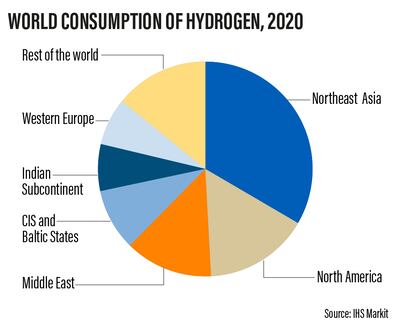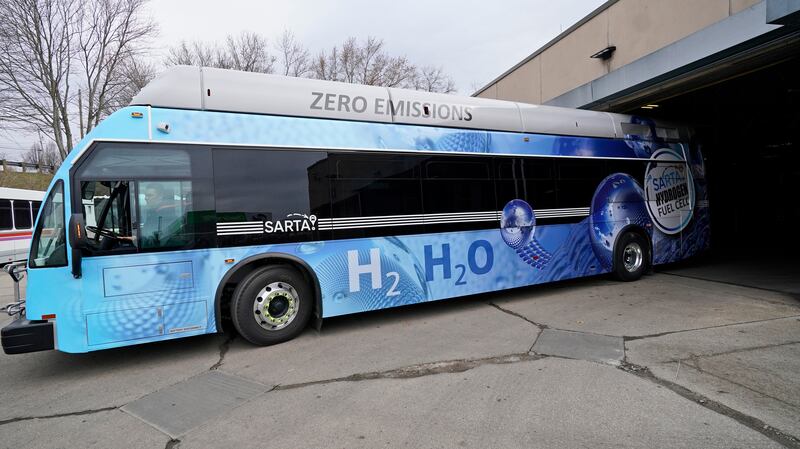Hardly a day goes by without more announcements in the field of hydrogen. This year’s Gastech conference, which concluded last week in Dubai, brought yet more advances.
The UAE has natural and created advantages in this new energy carrier. And it can take further steps to capitalise on this.
At the event, Dr Sultan Al Jaber, Minister of Industry and Advanced Technology and managing director and group chief executive of Adnoc, repeated the ambition for the UAE to lead in “blue” hydrogen, made from natural gas.
The National Petroleum Construction Company formed a joint venture with French engineering firm Technip to co-operate on hydrogen.
Earlier this month, after the UK visit by Sheikh Mohamed bin Zayed, Crown Prince of Abu Dhabi and Deputy Supreme Commander of the Armed Forces, Adnoc, Masdar and BP announced plans to produce two gigawatts equivalent of hydrogen across the two countries.
Projects are under way to produce hydrogen and/or ammonia at the Ta’ziz industrial hub at Ruwais, the Dubai Expo site, and two at Kizad.
The prize for the GCC is vast: up to $100 billion in export earnings by 2050. Our latest study of the UAE’s hydrogen opportunity and strategy, with the assistance of Adnoc, ADQ, Mubadala and the Ministry of Energy, identified the country’s key strengths in this emerging field.
For “blue” hydrogen, it has enormous and low-cost hydrocarbon resources, deep underground geological formations for safe permanent disposal of carbon dioxide, and experience in hydrogen production and carbon capture, use and storage (CCUS). Adnoc already produces 300,000 tonnes of hydrogen annually, set to increase to 500,000 tonnes. It captures 0.8 million tonnes of carbon dioxide, which is intended to reach five million tonnes by 2030.
For “green” hydrogen, made by splitting water through electrolysis using renewable energy, it has among the world’s lowest solar power costs, and large expanses of available sunny land.
And for both forms, the UAE has excellent supporting infrastructure such as ports, a business-friendly system, and openness to international partnerships. Still, these advantages are not enough on their own.
The only country with the large low-cost gas reserves and ready market access to challenge the GCC states as a blue hydrogen exporter is Russia.
Canada and the US will be large players, but probably mostly within their continent. American, Russian and Algerian exports to Europe would be disadvantaged by high methane leakage from their natural gas industries.
Green hydrogen will be a much more competitive game, as solar, wind and empty land are widespread. Chile and Australia have already moved quickly to announce large projects, various countries in North Africa have ambitions and offshore wind will support numerous production sites in north-west Europe.
We found the UAE could potentially produce blue hydrogen for $1.3 per kilogram and green hydrogen for just over $2 per kilogram. This compares very favourably with global ambitions to bring the fuel’s costs below $2 by 2030, equating to about $15 per million British thermal units of gas. Though expensive in historical terms, current gas prices in Europe and Asia are higher and taxes for carbon dioxide emissions would substantially close the gap.
Indeed, the current surge in gas prices and fears of shortages illustrate exactly why we need hydrogen. As a near-zero carbon energy source with multiple production methods and flexible end-uses, it can be stored relatively easily. It will be increasingly important for powering industry and backing up renewable-dominated systems when solar and wind power fall short.
The next four steps in the UAE’s hydrogen journey are as follows. Firstly, to build up the scale and bring down the cost and carbon footprint of blue hydrogen. CCUS systems can be fitted to existing installations and designed into new ones.
Secondly, to do the same for green hydrogen. This requires new massive ultra-cheap renewable ventures in the style of the Al Dhafra solar farm in Abu Dhabi, currently the world’s largest, and the Mohammed bin Rashid Solar Park in Dubai, the biggest multi-project site. Understanding the best blend of solar photovoltaic, solar thermal, batteries and nuclear power will lower costs while enabling electrolysis plants to run closer to their maximum capacity day-round and year-round.
Electrolysers are a key bottleneck: only a few companies make them, and they are quickly being booked up for years ahead. This could be an opportunity for local manufacturing and partnerships with international suppliers. Cutting their requirement for precious metal components would reduce costs.
Thirdly, establishing the hydrogen market. Local industries such as steel and fertilisers can use hydrogen to cut their carbon footprint, increasingly essential if the EU and other blocs impose restrictions on high-carbon imports.
A domestic base should be established for hydrogen or its derivative, ammonia, as a fuel for shipping. Introducing a gradually increasing carbon price would raise government revenue, encourage innovation, aid the UAE’s compliance with its Paris Agreement climate targets, and give incentives to use hydrogen and other clean fuels.
But export customers are the key prize. Australia is closer to East Asia, North Africa to Europe. Therefore, while the country can access both these emerging hydrogen importers, the biggest long-term prize may be south Asia. As well as shipping hydrogen or ammonia, the UAE could become a centre of making energy-intensive goods, as it already has done for aluminium.
The country needs to engage diplomatically, especially in Europe, to ensure a suitable market model for hydrogen, and to secure acceptance of blue hydrogen as a valid low-carbon option.
Fourthly, generating maximum value domestically. That demands a careful assessment of which components and services can be provided here, and openness to other opportunities, perhaps unexpected ones, that the hydrogen economy creates. The coming year promises a lot more excitement – and hopefully real progress.
Robin M. Mills is CEO of Qamar Energy, and author of The Myth of the Oil Crisis







